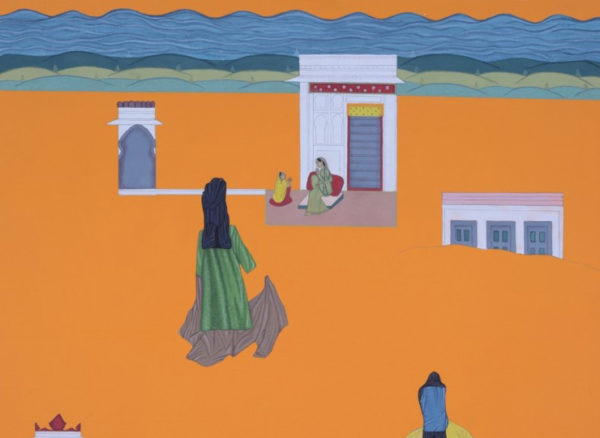
Posted: February 2nd, 2016 -
Category: Interviews, News
THE CALL OF THE WEST: INTERVIEW WITH THUKRAL AND TAGRA
Jiten Thukral and Sumir Tagra are a dynamic artist duo based in Delhi, who have been collaborating since 2004. Trained in design, their work incorporates symbols and images from popular culture which appeals to a global audience, addressing universal themes of identity, consumerism and change.

The series title ‘Windows of Opportunity’ is related to migration issues.
How important is this theme to you?
ST: We both come from the Punjab in India, where the idea of success is very different. Travelling abroad is seen as a status symbol, and many young Punjabis move to Western countries because the opportunities are better.
JT: After my schooling, the son of my father’s friend went abroad, so there became pressure on me to go abroad too. And then families will do things like start selling their land to fund their children’s studies; this is very common. For every family in Punjab there will be one person who has moved abroad.
ST: And not all the Indian students who go abroad are really ‘students’ either – they will try desperately to use the time to do as many things as possible that allows them to settle abroad.
JT: In Jalandhar, there are apparently five hundred applicants who apply every day for a UK visa! But after I finished art school, I stayed in India to do my Masters in Chandigarh, and that’s where we both started making projects such as the Bose DK t-shirts. I did go abroad, but when I came back people kept asking ‘why did you come back?’
A loving family motto to have.
JT: (laughs) Yes, but it’s true! And then when you are back, family members will visit and they will bring younger sons along and ask you to take them with you, to help them with opportunities.
ST: At our studio in Delhi we used to have kids come and visit and we would feel obliged to guide them, and act as a sort of mentor for them. A kind of precursor to the exhibition in Singapore would be our Art Basel installation in 2007, called “Adolescere Domus”, which was about aspirations of the young Punjabi population who are desperate to move abroad. So that work was based on the years of research we did about all the kids leaving from Jalandhar, and this is something we still find relevant and that still requires a social commentary.

What was the reception like for that work?
ST: People loved it, they understood what we were trying to say, and I think we found our ideal aesthetic in that too.
JT: So we have been documenting all these Punjabi people, and six years later not much has changed – ninety percent of people will still say the same thing, that they want to go abroad.
Do you think that is something to do with the media? Is there some sort of unachievable ideal that is being proliferated through popular culture?
ST: Yes, maybe that is the case. Coming from a design background, we are familiar with advertising, and there does seem to be a message coming through with the popular culture in India. And nothing is changing about it, because when I go back home people still have the same stories, the same dream of a big house in the UK.
You both followed an unconventional route in India by choosing to study art? Did you face any issues along that path?
ST: There is often a lot of pressure to study subjects like medicine or engineering, but it depends on your family’s background. Jiten’s dad is an artist and he runs a studio, so he understands what it’s like and was always supportive. For me, I learned painting and drawing from my mother. So luckily for the both of us, our families never tried to get between us and our creative ideas. But we see a lot of friends of ours who do struggle, and even for us it is hard sometimes to explain what we do to people back home.
You come from a design background, and your work has a very distinctive style that reflects that. Is approaching art from the design and engineering angle a more viable way of becoming an artist in India?
JT: It definitely helps. But it also depends on gender; in my art classes in Chandigarh, 18 out of the class of 20 were girls. There is a definite gender bias towards girls going down the creative path, but even then it is often not necessarily for a career.
To what extent did your family background influence your style?
JT: Well to start, I used to work in my dad’s design studio, and I learnt the technique for spray painting when I was eight years old!
ST: Exactly, it came very naturally to us. Most of our techniques come from our family backgrounds.
JT: My uncle used to have a cinema hall, so they even used to make film sets. At one stage there was this huge studio, with over twenty artists working for us to make billboards!
ST: So we’ve really grown up with this stuff – the planning, the execution, the techniques.
JT: We have two assistants that help us to paint, and they used to actually be my uncle’s assistants who were painting the billboards etc. But it was hard for them to make money, so they switched to driving taxis and trucks instead. So we said why don’t we support them? Then they can see what we are doing, and their kids can see what we are doing. We want them to become artists in their own right, not to be stuck as assistants forever. But even our assistant has the same dream of going abroad! So we come full circle back to the exhibition theme and this problem of a growing Punjabi diaspora. Hopefully we can translate this message to a global audience through our works.










Comments